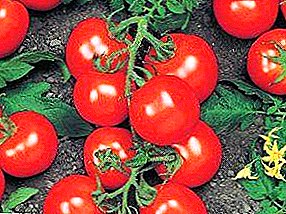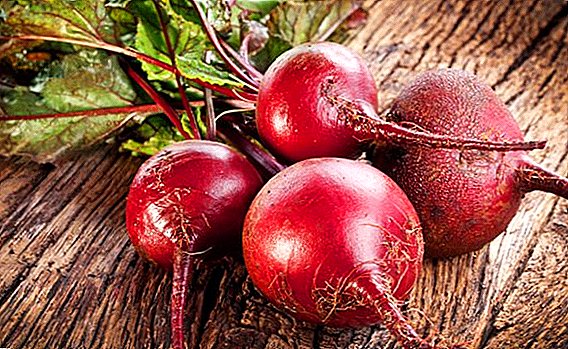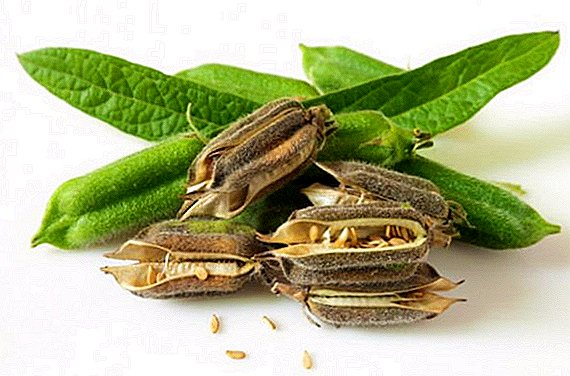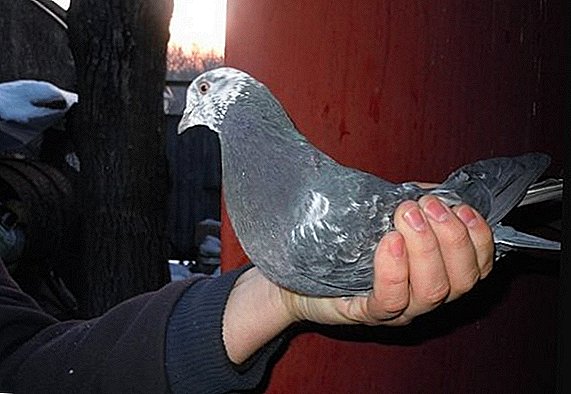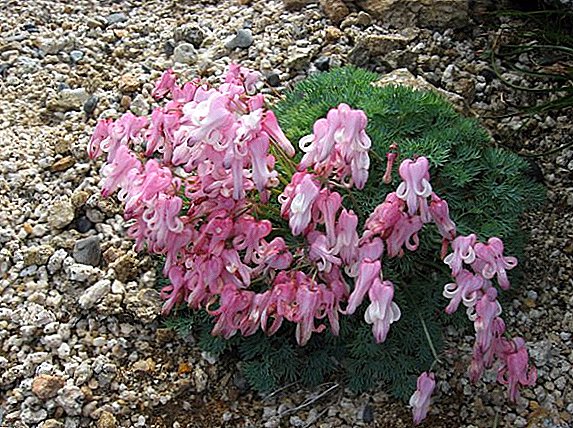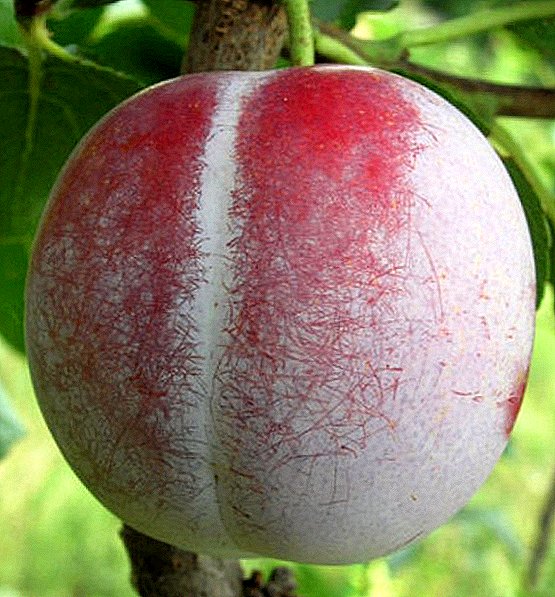 Plum - perhaps the most common fruit tree, a few farms or suburban area do without it. The wonderful taste of the fruit brought her well-deserved popularity. On one of the most famous varieties of plums - "Renklod" - we will tell in our article.
Plum - perhaps the most common fruit tree, a few farms or suburban area do without it. The wonderful taste of the fruit brought her well-deserved popularity. On one of the most famous varieties of plums - "Renklod" - we will tell in our article.
Description and main characteristics of the species
The ancestors of this plum are Greece, Italy, Germany and Spain. At its core, "Renklod" is the result of crossing thorns and plums, its fruits have a delicate dessert taste and tender flesh.
Did you know? The life of a plum tree is no more than 25 years, of which the productive period is from 10 to 15 years.
Wood
The height of the tree, as a rule, reaches 5-7 m. The krone is round, the branches in the period of youth are springy, red-green or red-brown, the hairiness is small. In the period of growing branches lose fleecy, and the bark of the tree becomes gray.  Petioles with a fluff become reddish with age; leaves in the lower part are lowered to the ground, on veins - oblong hairs.
Petioles with a fluff become reddish with age; leaves in the lower part are lowered to the ground, on veins - oblong hairs.
Flowering occurs in the last days of May.
Fruits
Fruits about 5 cm long, are either spherical or egg-shaped, with points on both sides. The weight of the fruit depends on the variety of plum variety and ranges from 10 to 50 g, and its color varies from green-yellow to blueberry-black.  The fruit is covered with a thin layer of wax, which is easily erased, and if you touch it, you will find its slight roughness. The skin is thin, the flesh under it is very sweet, juicy and melting in the mouth.
The fruit is covered with a thin layer of wax, which is easily erased, and if you touch it, you will find its slight roughness. The skin is thin, the flesh under it is very sweet, juicy and melting in the mouth.
From the plum, you can create a variety of blanks that will provide the missing vitamins. We recommend to learn what can be cooked from the plum for the winter, including how you can: pickle, make jam, cook compote, make plum wine and make prunes.
Fruit development does not have a periodicity and depends only on the summer weather. Dry and warm weather contributes to their active development, but dampness and coolness make the fruit smaller, adding sourness to their taste.
Variety "Renklod"
There are several of the most popular because of their excellent taste and botanical qualities of the Renklod plum varieties. We will try to tell about them in more detail.
"Green"
When this variety arose, it is not known for certain, but Renklod Green is considered the patriarch of all types of plums of this variety, so we’ll dwell on it in more detail. There is an assumption that the plum appeared in Greece, then came to Italy, and from there it was brought to France.
It is cultivated in Central Ukraine, in the Rostov, Kursk and Voronezh regions, in the North Caucasus, as well as in Kazakhstan.  It is characterized by a tall tree - in the tenth year it grows from 6 to 7 m, and in the girth it reaches 6.5–7 m. The trunk from the root to the top is wide, with meanders. The branched part of the tree with foliage is moderately dense, rounded and wide.
It is characterized by a tall tree - in the tenth year it grows from 6 to 7 m, and in the girth it reaches 6.5–7 m. The trunk from the root to the top is wide, with meanders. The branched part of the tree with foliage is moderately dense, rounded and wide.
It will be interesting for you to read more about the benefits and harms of plums, as well as about the diversity and cultivation of such varieties of plums, such as: homemade, Hungarian, Chinese, peach, durnos, and a hybrid of sharafuga plum.
Thick fruiting branches, bark of gray with a slightly red tint. The leaves are large, oval-shaped, with dense skin.
The plums themselves seem little attractive, but extremely tasty and very sweet. The taste of plum "Green" is considered a reference. In size, fruits are medium, from 33 to 40 g, although they are even smaller, rounded, slightly flattened from above and below, in shape.  The cover of the "Green" is thin, yellow-greenish, the side to the sun is yellow, has crimson dots and specks, is covered with intense bloom. Stone is small, relief and rounded, adherent half.
The cover of the "Green" is thin, yellow-greenish, the side to the sun is yellow, has crimson dots and specks, is covered with intense bloom. Stone is small, relief and rounded, adherent half.
Fruiting begins in the fifth year from the date of transplantation into the open land. Fruits reach maturity in late August. The first few years, the tree gives from 25 to 30 kg of plums, but, starting from the tenth year, you can collect from 45 to 50 kg of plums from one tree.
Variety "Renklod Green" has excellent winter hardiness and disease resistance.
"Yellow"
Tree height from 5 to 6 m, grows quickly. The branched part of the tree with foliage is wide, but not very dense.
Fruits are almost spherical, somewhat flattened laterally, covered with a thick layer of wax. On weight about 30 g. The peel has a sunny yellow color. The flesh of the fruit is green with yellow, great juiciness, the juice of this plum is colorless.
The taste of the fruit is sweet and sour (the acidity is high in vitamin C - over 17.5 mg per 100 g).  The fruits ripen in late August - early September. From a young tree, you can collect from 8 to 10 kg of plums, from an adult - from 20 to 30 kg.
The fruits ripen in late August - early September. From a young tree, you can collect from 8 to 10 kg of plums, from an adult - from 20 to 30 kg.
This subspecies of "Renklod" has good winter resistance - it can tolerate frosts down to -25 ° C.
We advise you to read about popular varieties of yellow plums.
"White"
A tree of this variety grows up to 4-4.5 m. White plums, matte and smooth, weighing 35-40 g, the tree gives the first fruits in the third year of life.
Transparent bulk pulp plums extremely sweet. The collection of plums falls on the third decade of the last summer month. Frost resistance is good. 
"Blue"
The tree grows in height slightly more than 3 m. The crown is oval in shape, sloppy in appearance, average density, sparse. Ink-violet fruits are similar to a ball (can be flattened). By weight - 40 g.  Have a gray-turquoise wax layer. The pulp is lemon, delicate, taste sweet, with weak sourness. First fruits - for the third year.
Have a gray-turquoise wax layer. The pulp is lemon, delicate, taste sweet, with weak sourness. First fruits - for the third year.
Frost resistance: up to -30 ° C.
"Altana"
This species originated in the XIX century as a spontaneous mutation during the cultivation of Greenstone green stone. The tree with a crown in the shape of a ball, reaches 6.5 m in height. Plums are large, weighing 40-45 g, somewhat compressed from the sides.
The peel is light green, with a pink-red color. The golden flesh is extremely delicate and appetizing.
Harvests in the third year, initially 35-40 kg, with growth - up to 80 kg. Harvesting takes place in early August, in cool areas - later a couple of weeks. For every 4-5 year of fruit does not bring.
Frost-resistant hybrid. 
"De bove"
And this subspecies is the result of a random mutation. They grew "Renklod Green", and a new species appeared from its bones. The tree is of medium height, with branches growing in all directions, which is why the crown looks untidy.
Fruits are yellow-green, similar to the ball, on the sides - garnet tint. On the peel of a dense wax coat of silver shimmer. Delicious flesh with a faint musk shade.
Fruits ripen by mid-September, with a ten-year-old tree, they can be collected up to 40-50 kg, and from twenty years old - twice as much. In contrast to the excellent harvest, "De Beauvais" has low frost resistance. 
"Early"
This variety was bred in the 50s of the XX century in Ukraine by the method of pollination of 2 varieties: "Jefferson" and "Peach". The six-meter tree has a sparse crown similar to a ball.
Plums are round, yellow-orange, with a faint whitish tint, slightly compressed from the sides, one half of the plum is larger than the other. The weight of a plum from an adult tree is 60 g, with time it becomes smaller - 35-40 g. Sweet and sour pulp with some honey taste.
Harvesting in the last days of July - in the first decade of August.
Frost resistance: up to -30 ° C. It also withstands extreme heat. 
"Collective farm"
This is the result of the work of I.V. Michurin, who bred him as a result of the hybridization of the old South European "Green Lack" with a local stable shale. The tree is relatively low - 2.5 m, but with a sprawling spherical crown, although not thick.
The fruits are small, one plum weighs about 15-20 g. The rind is yellow-green, has many subcutaneous points. If you are in direct sunlight for a long time, you may get a blush of brick shade. The wax coat is easily removed.
The flesh of the fruit is juicy and delicate, but slightly more sour than the other Greenclaws.
Crop harvested in the last days of August. A young tree gives 20 kg, an adult - up to 40 kg.
The tree can tolerate frosts down to -30 ° C. 
"Soviet"
The variety was bred in the 80s of the last century by cross-pollination of the “Renklod” and “Renklod Ulyanischeva” plums. The height of the tree is no more than 3.5 m. The crone is disheveled, the leaves are small, the branches, gradually expanding, tend upwards.
Round plums, dark lilac with a cover. Pulp with amber tint. Sweet to taste and a little sour.
Productivity starts in the fourth to fifth year. By the last days of August, the young tree gives 15-20 kg of plums, mature - 40-45 kg.
Frost resistance and disease resistance - high. 
"Karbysheva"
Bred in Ukraine in the 50s of XX century. The tree is fast growing, so it needs regular pruning. Plums are like a ball, their skin is bright garnet, if the plum overrips, there will be a wax blue cover.
The flesh is similar in color to honey, according to taste by professionals it is defined as dessert.
Check out the best varieties of plums for your garden.
Fruits in the second half of August.
Winter hardiness: above -20 ° C no longer tolerate. 
"Tambov"
He was taken out by crossing the "Renklod Green" and "Early Red". Trees up to 3.5 m in height, in a spreading crown about 3 m wide.
Beginning of fruiting - after 3 years. Can give up to 25 kg of very high quality dark-colored plums of 20 g each. The flesh is wheat-colored, the taste is sour.
Frost resistance: up to -30 ° C. 
"Tenkovsky"
Another name - "Tatarsky". Varieties of parents - plum "Tatar yellow", "Jefferson", "Renklod Reform" and turn "Local". The tree is small - up to 3 m, with a neat crown in the form of a ball. Rounded asymmetrical plums, one half a little more than the other.
The purple skin has a turquoise bloom. The flesh is yellow, lumpy, without juiciness. The taste is sweet and sour.
The harvest gives, starting from 4-5 years, the fruits are small (weighing about 18 g), ripen late, by mid-September.
Winter hardiness is low. 
"Michurinsky"
This variety was bred at the beginning of the XXI century with the help of cross-pollination of the plum "Eurasia 21" and "Renklod Altana". Low tree with a neat crown in the shape of a ball, moderate thickening.
Plums with red-lilac skin and numerous subcutaneous spots. The flesh is sweet and sour, carrot color, emitting a lot of golden juice. Plum weight - up to 25 g.
Did you know? Wild plum does not exist in nature. Plum - the result of crossing about two thousand years ago, cherry plum and thorns.
It starts harvesting at 3 years, the fruits ripen in early September, up to 25 kg of plums can be harvested from an adult tree.
Cold resistance is good. 
"Presidential"
The “parents” of this species are the “Renklod of Altana”, “Hungarian Azhanskaya” and the “Great Blue” plum. The tree reaches a height of 4 m, the crown is sloppy, similar to a broom handle downwards. Fruits are ellipsoidal with thick violet skin.
Thick pulp, bulk, granular, with a yellow carrot shimmer. The taste is sour. On weight - about 55 g.
To rejoice in harvest the tree begins at 4 year. From a young tree can be collected from 12 to 15 kg, with an adult - up to 45 kg.
Winter hardiness is excellent. 
Growing conditions
In order for the harvest to be rich and the tree itself to be healthy, it is necessary to choose the planting place correctly, or rather, to consider the following factors:
- the soil should be fertile and loose, preferably with either low or neutral acidity;
Find out what is important soil acidity for plants, how to determine the acidity of the soil at the site, how to deoxidize the soil, as well as how to improve soil fertility.
- access to the sun and lack of shade - otherwise the crop will be low;
- in the place of landing there should not be large ground waters - too much moisture provokes tree diseases;
- avoid low-lying places - there is going to melt and rain water;
- planted next to buildings and fences - it is necessary to protect against large gusts of wind and drafts;
- due to the fact that the “green trees” are self-productive, it is necessary that the pollinating trees be near;
- the distance between the trees should be 2-2.5 m.
Landing rules
Strict adherence to the rules of landing is no less important than the correct choice of place. Over the coming year, it is necessary to prepare a landing pit.  Sapling "Renklod" To do this, you need to dig a hole: 0.6 m deep and 0.8 m in diameter. At the same time, the removed topsoil should be set aside separately from the bottom layer. The next stage is the preparation of soil mixture. Its composition is:
Sapling "Renklod" To do this, you need to dig a hole: 0.6 m deep and 0.8 m in diameter. At the same time, the removed topsoil should be set aside separately from the bottom layer. The next stage is the preparation of soil mixture. Its composition is:
- fertile ground layer;
- two buckets of humus or manure;
- 50 g of superphosphate;
- 30 grams of potassium sulfide.
Pour the prepared mixture into the pit and cover it with barren soil.
Important! Plum trees are prone to rotting roots.
In the spring, with direct landing, you should adhere to the following sequence of actions:
- First, insert two support pegs into the pit.
- Lowering the seedling into the hole, make sure that the root neck is 5-7 cm above ground level.
- When the sapling is covered with soil, it should be gently shaken to fill the voids between the roots.
- Along the circumference, dig a notch with a depth of 40 to 50 cm.
- After this, the seedling should be tied to support pegs, but without a strong stretch of rope, so as not to damage the tree.
- In conclusion, it is good to water it with clean water and cover the soil with mulch.
Video: how to plant plum
Basics of seasonal care
As well as choosing the right place for planting, good care of the trees is just as important. One of the most important features of care is the need for additional pollination. There are two ways: planting next to the plum of pollinating trees or artificial pollination with the help of special pollen.
Familiarize yourself with plum pest control methods, especially with aphids and shields.
Soil care
It is not much different from the usual care of plums, but still there are some features:
- watering should be done five or six times a season (for this purpose, the settled warm water is optimal, its amount depends on the age of the tree, but usually it is from 4 to 8 buckets);
- the stem should be kept clean and regularly loosened;
- you should not make a lawn or grow flowers under a tree;
- radical growth needs to be deleted.
Top dressing
The first two years after planting the tree takes nutrients from those fertilizers that were laid during planting, but from the third year you need to start feeding. And this should be done according to the rules described below:
- In April, before flowering, the tree at the bottom should be sprinkled with a composition consisting of 25 g of ammonium nitrate, 40 g of potassium salt and 300 g of mineral fertilizers. Then water well;
- when the flowering period has come, it is necessary to water it with a solution of urea: dilute 10 g of urea in 5 l of water;
- after flowering, a 0.3% solution of mullein and 50 g of superphosphate should be added as a top dressing;
- when fruits ripen, plum needs to be fed with a solution consisting of 4 tbsp. l carbamide, 6 tbsp. l nitrophosphate and 20 liters of water;
- in the summer (approximately from the first to the fifth of June) it is necessary to spray the tree with 1% urea solution;
- in the fall, when digging in, add: 15 kg of manure, 150 g of superphosphate and 50 g of ammonium nitrate;
- then pour a solution consisting of 4 tbsp. l sulfuric potassium, 6 tbsp. l superphosphate and 20 liters of water.

Pruning
It is made in early spring, after the leaves bloom, or in early June. These are the safest periods. Trimming is carried out by year:
- First year - for the formation in the future of the correct spherical shape of the crown of a tree, ten skeletal branches are distinguished with an equal distance and angle from the trunk of 45 °;
- second year - remove all increments, the length should be 25 cm;
- third year - shorten shoots from skeletal branches and a conductor so that they are 30 cm long, the rest of the growth should be 15 cm long;
- fourth year - the crown has already been formed, further sanitary pruning is done: removal of diseased and dry branches, and also make sure that the crown does not thicken due to new shoots and let the sunlight through.
Video on how to properly trim the plum (and sweet cherry)
Important! If the branches tend to the ground under the weight of the harvest - they need to be supported with supports. Places of contact between the wood and the support must be softened with foam rubber or a soft cloth.
Preparing for the winter
To prepare the "Renklodes" for icy times should be as follows:
- shelter young trees with spruce, sedge or hay; if not, then you can simply wrap the paper;
- mature trees should be whitened from the root collar to the first skeletal branch and sprinkle at the bottom with a layer of sawdust or humus not less than 10 cm.


